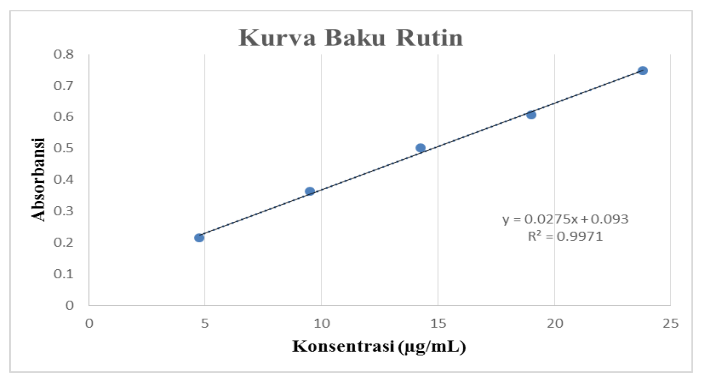Main Article Content
Abstract
Jamu is still the choice of Indonesian people as an alternative to modern medicine until now. As a cultural heritage of the Indonesian, jamu is still very popular from the west to the east of Indonesia. The enthusiasm of the Indonesian in consuming jamu has encouraged many traditional medicine industries to produce jamu with many kinds of claim. Jamu "X" is claimed to help maintain body health. This research was conducted to determine the total flavonoid content in jamu "X" calculated as rutin by UV-spectrophotometric method with aluminum chloride (AlCl3) reagent. Jamu "X" is a product with new formula that is expected to be marketed soon. The determination of the maximum absorbance wavelength of rutin was carried out at a wavelength of 400-800 nm and the resulting maximum absorbance wavelength of rutin was 416.5 nm. The determination of total flavonoid calculated as rutin determined using a linear regression equation from the rutin standard. The linear regression equation was determined from a rutin standard curve series with 10; 12.5; 15; 17.5 and 20 g/ml, respectively and the linear regression equation obtained y = 0.0275x + 0.093. The results of the determination of rutin in the jamu "X" were 1.474%; 1.474% and 1.469% with an average value of 1.472%.
Keywords
Article Details

This work is licensed under a Creative Commons Attribution-NonCommercial 4.0 International License.
References
- Andriati, A., & Wahjudi, R. M. T. (2016). Tingkat Penerimaan Penggunaan Jamu Sebagai Alternatif Penggunaan Obat Modern pada Masyarakat Ekonomi Rendah-Menengah dan Atas. Masyarakat, Kebudayaan dan Politik, 29(3), 133–145.
- Anggorowati, D. A., Priandini, G., & Thufail. (2016). Potensi Daun Alpukat (Persea americana Miller) Sebagai Minuman Teh Herbal yang Kaya Antioksidan. Industri Inovatif:Jurnal Teknik Industri, 6(1), 1–7.
- Azizah, Z., Elvis, F., Zulharmita, Misfadhila, S., Chandra, B., & Yetti, R. D. (2020). Penetapan Kadar Flavonoid Rutin pada Daun Ubi Kayu (Manihot esculenta Crantz) Secara Spektrofotometri Sinar Tampak. Jurnal Farmasi Higea, 12(1), 90–98.
- BPOM. (2004). Peraturan Kepala BPOM Nomor HK.00.05.23.3644 Tentang Ketentuan Pokok Pengawasan Suplemen Makanan. Badan Pengawas Obat dan Makanan, Republik Indonesia.
- Chang, C.-C., Yang, M.-H., Wen, H.-M., & Chern, J.-C. (2002). Estimation of Total Flavonoid Content in Propolis by Two Complementary Colorimetric Methods. Journal of Food and Drug Analysis, 10(3), 178–182.
- Dai, Y., & Row, K. H. (2022). Determination of Rutin from Ginkgo biloba L. Leaves by Ultrasound-Assisted Extraction with Natural Deep Eutectic Solvent-Based Cellulose Polymers and High-Performance Liquid Chromatography (HPLC). Analytical Letters, 55(4), 566–579.
- Depkes RI. (2000). Parameter Standar Umum Ekstrak Tumbuhan Obat: Vol. Cetakan Pertama. Direktorat Jenderal Pengawasan Obat dan Makanan, Direktorat Pengawasan Obat Tradisional, Departemen Kesehatan Republik Indonesia.
- Depkes RI. (2013). Hasil Utama Riset Kesehatan Dasar. Badan Penelitian dan Pengembangan Kesehatan, Departemen Kesehatan Republik Indonesia.
- http://ejournal.litbang.kemkes.go.id/index.php/vektorp/article/view/6252
- Depkes RI. (2018). Hasil Utama Riset Kesehatan Dasar. Badan Penelitian dan Pengembangan Kesehatan, Departemen Kesehatan Republik Indonesia.
- http://ejournal.litbang.kemkes.go.id/index.php/vektorp/article/view/6252
- Gunathilake, K. D. P. P., Ranaweera, K. K. D. S., & Rupasinghe, H. P. V. (2018). Analysis of Rutin, Β‐Carotene, and Lutein Content and Evaluation of Antioxidant Activities of Six Edible Leaves on Free Radicals and Reactive Oxygen Species. Journal of Food Biochemistry, 42(5), 1–9.
- Harmita, H. (2004). Petunjuk Pelaksanaan Validasi Metode Dan Cara Perhitungannya. Majalah Ilmu Kefarmasian, 1(3), 117–135.
- Kapoor, M., & Rani, J. (2019). Determination of Vindoline and Rutin Content in Five Different Morphotypes of Catharanthus roseus Leaves Using HPLC. International Journal of Pharmacy and Pharmaceutical Sciences, 11(8), 52–57.
- Kemenkes RI. (2010). Peraturan Menteri Kesehatan No. 003 tentang Saintifikasi Jamu. Kementerian Kesehatan Republik Indonesia.
- Kemenkes RI. (2017). Farmakope Herbal Indonesia Suplemen II: Vol. Edisi I (First). Kementerian Kesehatan Republik Indonesia.
- Patel, K., & Patel, D. K. (2019). The Beneficial Role of Rutin, A Naturally Occuring Flavonoid in Health Promotion and Disease Prevention: A Systematic Review and Update. In Bioactive Food as Dietary Interventions for Arthritis and Related Inflammatory Diseases (pp. 455–477).
- Patle, T. K., Shrivas, K., Kurrey, R., Upadhyay, S., Jangde, R., & Chauhan, R. (2020). Phytochemical Screening and Determination of Phenolics and Flavonoids in Dillenia pentagyna Using Uv–Vis and FTIR Spectroscopy. Spectrochimica Acta Part A: Molecular and Biomolecular Spectroscopy, 242, 118717.
- Suharyanto, S., & Hayati, T. N. (2021). Penetapan Kadar Flavonoid Total Ekstrak Buah Gambas (Luffa acutangula (L.) Roxb.) dengan Metode Spektrofotometri UV-Vis. Pharmacon: Jurnal Farmasi Indonesia, 18(1), 82–88.
- Wardhani, L. K., & Sulistyani, N. (2013). Uji Aktivitas Antibakteri Ekstrak Etil Asetat Daun Binahong (Anredera scandens (L.) Moq.) terhadap Shigella flexneri Beserta Profil Kromatografi Lapis Tipis. Pharmaciana, Jurnal Ilmiah Kefarmasian, 2(1), 1–16.
- Yingyuen, P., Sukrong, S., & Phisalaphong, M. (2020). Isolation, Separation and Purification of Rutin from Banana Leaves (Musa balbisiana). Industrial Crops and Products, 149, 1–9.
